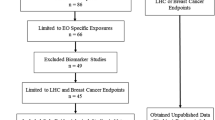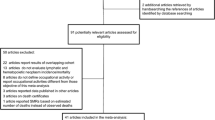Abstract
The estimated occupational ethylene oxide (EO) exposure concentrations corresponding to specified extra risks are calculated for lymphoid mortality as the most appropriate endpoint, despite the lack of a statistically significant exposure–response relationship. These estimated concentrations are for occupational exposures—40 years of occupational inhalation exposure to EO from age 20 to age 60 years. The estimated occupational inhalation exposure concentrations (ppm) corresponding to specified extra risks of lymphoid mortality to age 70 years in a population of male and female EO workers are based on Cox proportional hazards models of the most recent updated epidemiology cohort mortality studies of EO workers and a standard life-table calculation. An occupational exposure at an inhalation concentration of 2.77 ppm EO is estimated to result in an extra risk of lymphoid mortality of 4 in 10,000 (0.0004) in the combined worker population of men and women from the two studies. The corresponding estimated concentration decreases slightly to 2.27 ppm when based on only the men in the updated cohorts combined. The difference in these estimates reflects the difference between combining all of the available data or focusing on only the men and excluding the women who did not show an increase in lymphoid mortality with EO inhalation exposure. The results of sensitivity analyses using other mortality endpoints (all lymphohematopoietic tissue cancers, leukemia) support the choice of lymphoid tumor mortality for estimation of extra risk.
Similar content being viewed by others
Abbreviations
- Dow:
-
Dow Chemical Company
- EO:
-
Ethylene oxide
- IARC:
-
International Agency for Research on Cancer
- NIOSH:
-
National Institute for Occupational Safety and Health
- SMR:
-
Standardized mortality ratio
- UCC:
-
Union Carbide Corporation
References
Albertini RJ (2009) Ethylene oxide low potency mutagen low potency carcinogen. Presentation: ethylene oxide session, Toxicology Forum, Aspen Colorado
IARC Monographs on the Evaluation of Carcinogenic Risks to Humans (2008) 1,3-butadiene, ethylene oxide and vinyl halides (Vinyl Fluoride, Vinyl Chloride and Vinyl Bromide), vol 97. World Health Organization. International Agency for Research on Cancer. Lyon, France
Kirman CR, Sweeney LM, Teta MJ, Sielken RL Jr, Valdez-Flores C, Albertini RJ, Gargas ML (2004) Addressing nonlinearity in the exposure-response relationship for a genotoxic carcinogen: cancer potency estimates for ethylene oxide. Risk Anal 24(5):1165–1183
Sielken RL Jr (2009) Use of pooled epidemiology data in quantitative risk assessment. Presentation: ethylene oxide session, Toxicology Forum, Aspen Colorado
Stayner L, Steenland K, Greife A, Hornung R, Hayes RB, Nowlin S, Morawetz J, Ringenburg V, Elliot L, Halperin W (1993) Exposure-response analysis of cancer mortality in a cohort of workers exposed to ethylene oxide. Am J Epidemiol 138:787–798
Steenland K, Stayner L, Griefe A, Halperin B, Hayes R, Hornung R, Nowlin S (1991) A cohort mortality study of workers exposed to ethylene oxide. N Eng J Med 324(20):1402–1407
Steenland K, Stayner L, Deddens J (2004) Mortality analyses in a cohort of 18 235 ethylene oxide exposed workers: follow up extended from 1987 to 1998. Occup Environ Med 61:2–7
Swaen GM, Burns C, Teta JM, Bodner K, Keenan D, Bodnar CM (2009) Mortality study update of ethylene oxide workers in chemical manufacturing: a 15 year update. J Occup Environ Med 51(6):714–723
Teta MJ, Benson LO, Vitale JN (1993) Mortality study of ethylene oxide workers in chemical manufacturing: a mortality study. Br J Ind Med 50:704–709
Teta MJ, Sielken RL Jr, Valdez-Flores C (1999) Ethylene oxide cancer risk assessment based on epidemiologic data: application of revised regulatory guidelines. Risk Anal 19:1135–1155
Valdez-Flores C, Sielken RL Jr, Teta MJ (2010) Quantitative cancer risk assessment based on NIOSH and UCC epidemiological data for workers exposed to ethylene oxide. Regul Tox Pharmacol 56:312–320
Vogel EW, Nivard M (1998) Heritable and cancer risks of exposures to anticancer drugs: inter-species comparisons of covalent deoxyribonucleic acid-binding agents. Mutat Res 400:509–540
Acknowledgments
This manuscript is based on a December 16, 2010, slide presentation requested by the Scientific Committee on Occupational Exposure Limits (SCOEL). This work was financially supported by the CEFIC Ethylene Oxide & Derivatives Sector Group, Avenue Van Nieuwenhuyse 4, Box 2, B-1160 Brussels. The conclusions are those of the authors. The epidemiological data for the updated NIOSH study were obtained from the National Institute for Occupational Safety and Health through a Freedom of Information Act request (May 13, 2004). The epidemiological data for the updated UCC study were obtained under a November 19, 2008, confidentiality agreement between Union Carbide Corporation and Sielken & Associates Consulting, Inc.
Conflict of interest
The authors have served as EO consultants to the American Chemistry Council (ACC) and the European Chemical Industry Council (CEFIC). Statements of fact and opinion are those of the authors.
Author information
Authors and Affiliations
Corresponding author
Electronic supplementary material
Below is the link to the electronic supplementary material.
Rights and permissions
About this article
Cite this article
Valdez-Flores, C., Sielken, R.L. & Jane Teta, M. Quantitative cancer risk assessment for ethylene oxide inhalation in occupational settings. Arch Toxicol 85, 1189–1193 (2011). https://doi.org/10.1007/s00204-011-0669-2
Received:
Accepted:
Published:
Issue Date:
DOI: https://doi.org/10.1007/s00204-011-0669-2




